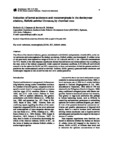Induction of larval settlement and metamorphosis in the donkey-ear abalone, Haliotis asinina Linnaeus, by chemical cues
- Global styles
- MLA
- Vancouver
- Elsevier - Harvard
- APA
- Help

閲覧/開く
日付
2004Page views
1,051ASFA keyword
AGROVOC keyword
Metadata
アイテムの詳細レコードを表示するCited times in Scopus
Share
抄録
The effects of the chemical inducers, gamma-aminobutyric acid (GABA) and potassium chloride (KCl), on the larval settlement and metamorphosis of the donkey-ear abalone, Haliotis asinina, was investigated. H. asinina larvae (5–6 h post-hatch) were exposed to a range of GABA (0.125–2.00 μM) and KCl (1.00–12.00 mM) concentrations for 72 h. Results of the dose response experiments showed that settlement and metamorphosis vary according to the dose levels of the inducer compounds. Under controlled laboratory conditions, 0.45–0.50 μM and 6.0 mM seemed to be the optima for GABA and KCl, respectively, as these concentrations elicited the greatest number of postlarvae that metamorphosed, settled or survived. However, GABA generally promoted better attachment and metamorphic response as well as survival than KCl in H. asinina postlarvae.
Suggested Citation
Gapasin, R. S. J., & Polohan, B. B. (2004). Induction of larval settlement and metamorphosis in the donkey-ear abalone, Haliotis asinina Linnaeus, by chemical cues. Hydrobiologia , 519(1-3), 9-17. https://doi.org/10.1023/B:HYDR.0000026480.00928.5a
Type
ArticleISSN
0018-8158; 1573-5117Collections
- Journal Articles [1229]

